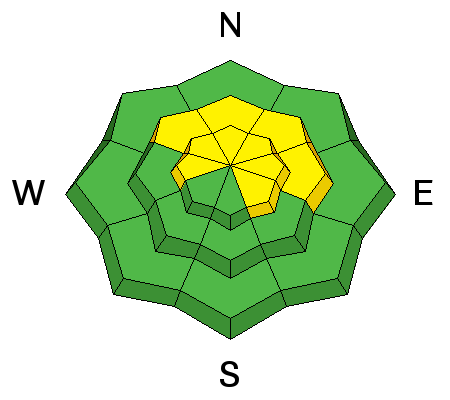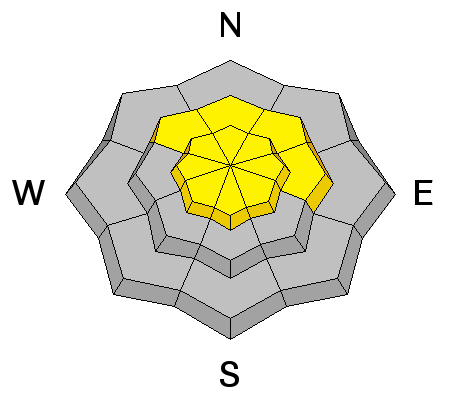25th Annual Black Diamond Fall Fundraising Party
Thursday, September 13; 6:00-10:00 PM; Black Diamond Parking Lot

25th Annual Black Diamond Fall Fundraising Party
Thursday, September 13; 6:00-10:00 PM; Black Diamond Parking Lot
| Advisory: Uintas Area Mountains | Issued by Craig Gordon for Tuesday - January 2, 2018 - 3:15am |
|---|
 |
current conditions Wow... what an amazing moon this morning! Skies are clear and temperatures in the teens and low 20's. East and northeast winds increased overnight and are blowing in the 20's and 30's along the ridges, gusting into the 40's near the high peaks. Recent winds have jacked a lot of the big open, upper elevation terrain, but soft snow is still found on mid elevation, wind protected slopes.
Above are 24 hour temperatures and snow depth from Trial Lake along with winds and temperatures from Windy Peak. More remote Uinta weather stations are found here Recent trip reports and findings can be seen here. Ted was up on Bald Mountain Pass recently, noting you can still see the summer hiking trail on Bald Mountain... a testiment to just how boney the range looks.. With it's easy access, Wolf Creek Pass is a seamless pre or post work grab. However... just 'cause you can see your rig from the ridge, doesn't mean the snowpack is good to go or shares your same level of stoke. Click here to view a great viddy and recent observation from this zone... thanks Dylan and Eric! |
 |
recent activity A BUSY WEEK IN REVIEW ON THE EASTERN FRONT- 12-26-17 In Chalk Creek, a rider was caught, carried, buried, and injured. Fortunately at the end of the day the rider came home... his sled however might need a rebuild. Ted's great viddy recap is found HERE Riders first hand account is posted here.
12-26-17
12-27-17 Ted and I rolled onto this slide on Double Hill just as the dust was settling. Averaging 4' deep and over 700' wide, this avalanche was triggered low on an adjacent slope. This is the kind of unpredictable avalanche dragon we're dealing with right now. Click HERE for more beta and a short viddy describing what we're seeing on the North Slope. More on this slide and other region-wide reports click here. |
| type | aspect/elevation | characteristics |
|---|


|


|

LIKELIHOOD
 LIKELY
UNLIKELY
SIZE
 LARGE
SMALL
TREND
 INCREASING DANGER
SAME
DECREASING DANGER
|
|
description
While avalanche activity has become more hit or miss the past few days, the fact remains, we have an unusual snowpack structure for the western Uinta's right now. No, it's not our usual weak mess of sugary snow that feels like a sandbox. On the contrary, it's actually comprised of a complex mix of crusts and fragile, sugary facets sandwiched in between. So... the snowpack has body and it has structure. It also has the Christmas storm on top that consolidated into a cohesive slab. We have all the ingredients for a slab avalanche and many steep, wind drifted slopes are just waiting for a trigger like us to come along and knock the legs out from underneath it.
Ted's pit above clearly illustrates what we're dealing with. Our problem child is a persistent slab and that's an issue because anything "persistent" in the snowpack takes a long time to heal. But we don't need to roll the dice and hope for the best. The way we manage this avalanche dragon is avoidance. Simply avoid the terrain the avalanche dragon lives in... steep, mid and upper elevation, wind drifted slopes, especially those facing the north half of the compass.
Chad was in the Hoyt Peak environs and experienced multiple large collapses as well as some interesting snowpit stability test scores. Click here for all the deets. The good news is, you don't have to stay home and hide under your bed. There's plenty of good riding on low angle slopes and big open meadows. In addition, there are plenty of south facing slopes throughout the range, like the one pictured above, where you can ride and you don't even have to deal with the issue of faceted snow. |
| type | aspect/elevation | characteristics |
|---|


|


|

LIKELIHOOD
 LIKELY
UNLIKELY
SIZE
 LARGE
SMALL
TREND
 INCREASING DANGER
SAME
DECREASING DANGER
|
|
description
Winds have been all over the map and they're loading slopes in an unusual fashion. While found mostly along the leeward side of mid and upper elevation ridges, I wouldn't be too surprised to find stiff drifts cross-loaded around terrain features like chutes and gully walls. Today you'll want to look for and avoid any fat, rounded piece of snow, especially if it sounds hollow like a drum. The snowpack is still relatively thin and the bummer with low tide conditions is, triggering even a small slide greatly increases your chances of slamming into a season ending rock or stump. |
 |
weather Skies will be mostly sunny with temperatures climbing into the mid 30's. Ridgetop winds gradually decrease as the day progresses. A gradual warming trend is on tap with much lighter winds into mid week. A slight chance of snow from a weakening warm front Thursday. Better chances come Saturday. |
| general announcements The information in this advisory expires 24 hours after the date and time posted, but will be updated by 7:00 AM Wednesday January 3, 2018. If you're getting out and about, please let me know what you're seeing especially if you see or trigger and avalanche. I can be reached at [email protected] or 801-231-2170 It's also a good time to set up one of our very popular avalanche awareness classes. Reach out to me and I'll make it happen. This information does not apply to developed ski areas or highways where avalanche control is normally done. This advisory is from the U.S.D.A. Forest Service, which is solely responsible for its content. This advisory describes general avalanche conditions and local variations always occur. |